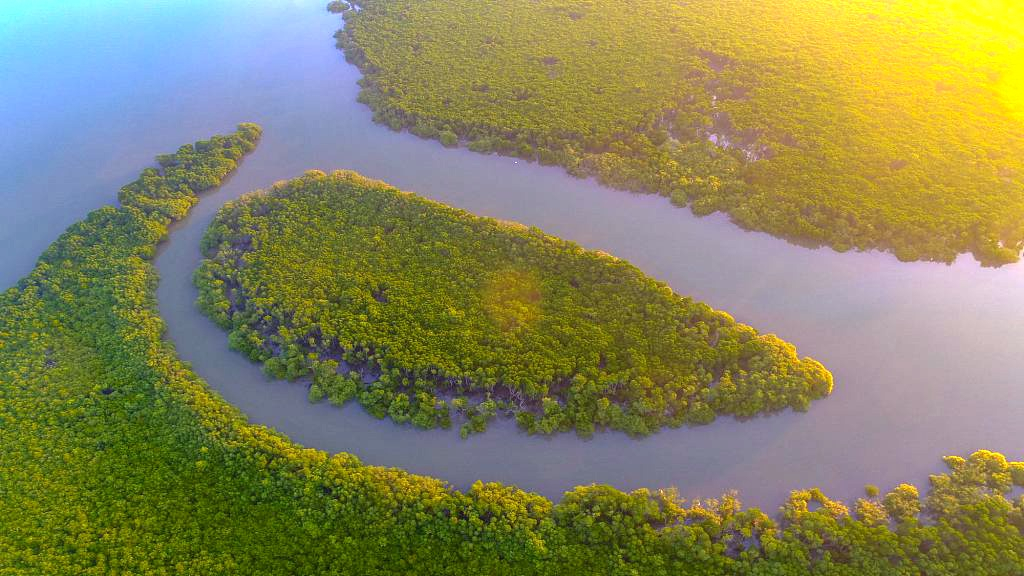
In spite of the water erosion on the coastline, plants like mangroves still flourish. In the previous episode, we see migratory birds stopping over in Yangtze and Yellow River Delta. In the last episode, we are going to find some amazing geological wonders and endangered marine animals in south China.
Fujian Province

A farmer carries a shoulder pole in Dongbi Villge, Ningde City, east China's Fujian Province. /VCG Photo
Near the East China Sea in east China's Fujian Province, there is a mysterious 7,000-year-old forest hidden in the sea. These 24 inconspicuous dark tree stumps on the beach are sometimes mistaken as rocks. It is said their buried parts can reach 20 to 25 meters.

Egrets rest on Keteleeria fortunei (Chinese: you shan). /VCG Photo
Most of the tree stumps are Keteleeria fortunei (Chinese: you shan), which is a coniferous evergreen tree native to China. These trees remain intact in spite of thousands of years of water erosion. It remains a mystery how the ancient forest lives with a 10,000-year-old oyster reef without any major Earth movements taking place in Fujian in the past 7,000 years.

Cage fish farming in Ningde City, Fujian Province. /VCG Photo
Now, the ancient forest and the oyster reef are both protected in Shenlu Bay Ancient Forest National Nature Reserve. This forest records the changing environment over the years, and is a great asset for geologists and archaeologists.
Guangdong Province

Nautilus swimming in blue water, Palau, Micronesia. /VCG Photo
As the first marine national nature reserve in south China’s Guangdong Province, Nanpeng Island Marine Ecosystem National Nature Reserve is an important habitat for plenty of endangered species, such as Chinese white dolphins and Nautilus that are under first-class state protection.

A Chinese white dolphin in the Zhujiangkou Chinese White Dolphin National Nature Reserve. /VCG Photo
The Zhujiangkou Chinese White Dolphin National Nature Reserve is particularly set up to protect “the giant panda of the sea.” The dolphins are usually pink instead of white. There are around 6,000 Chinese white dolphins left in the world with 5,000 living in China.

A green sea turtle. /VCG Photo
Every year, rescued sea turtles are released into the sea. Huidong Harbor Sea Turtle National Nature Reserve in Guangdong Province is the only nature reserve for sea turtles in Asia. The reserve is an important breeding ground for sea turtles, and is known as “sea turtle bay” by the locals.
Guangxi Zhuang Autonomous Region

Weizhou Island in Beihai City, south China's Guangxi Zhuang Autonomous Region. /VCG Photo
In south China’s Guangxi Zhuang Autonomous Region, there are 5 national marine nature reserves, including Weizhou Island Coral Reef National Marine Park and Beilun Estuary National Nature Reserve, which cover a total area of around 52,000 hectares.

Mangroves in Beihai City, Guangxi Zhuang Autonomous Region. /VCG Photo
In particular, the Shankou Mangrove Ecological National Nature Reserve is among the 5 foremost State Council-approved marine national nature reserves, which aims to protect the mangrove forest amounting to an area of 8,000 hectares.

A mangrove with roots like spider legs. /VCG Photo
Mangroves that grow in intertidal zones have roots like spider legs. Their complex roots system helps it deal with erosion from salt water and waves. They are also among the earth’s best carbon scrubbers, which can store carbon dioxide from the atmosphere for the long term.
Hainan Province

Mangroves in Haikou City, south China's Hainan Province. /VCG Photo
Hailed as “forest park on the sea,” Dongzhai Port Mangrove National Nature Reserve in south China’s Hainan Province boasts the largest forest in the coastal mud flat. The mangroves and wetlands provide shelters for numerous birds and fish.

The coral reef in Hainan Province. /VCG Photo
By 2010, 80 percent of hermatypic corals in Guangxi Zhuang Autonomous Region, Guangdong and Hainan provinces were lost due to human activities. Hermatypic corals are corals that build reefs. In Sanya Coral-reef National Nature Reserve, hermatypic corals, ahermatypic corals, coral reefs and the ecosystem are now under key protection.

A blue star (Linckia laevigata) rests under the coral reef in Hainan Province. /VCG Photo
Like mangrove forests, coral reef is an important marine ecosystem that supports 25 percent of all marine life. They are now endangered because of climate change, pollution and over-fishing.
After seeing all these incredible blue paradises along the coastline of China, which one is your favorite?
Read More:
The breathtaking blue paradises across China | Episode 1
The breathtaking blue paradises across China | Episode 2
(Cover image via VCG.)
(Deng Lehuai also contributed to the story.)
(If you want to contribute and have specific expertise, please contact us at nature@cgtn.com.)

Copyright © 2018 CGTN. Beijing ICP prepared NO.16065310-3
Copyright © 2018 CGTN. Beijing ICP prepared NO.16065310-3